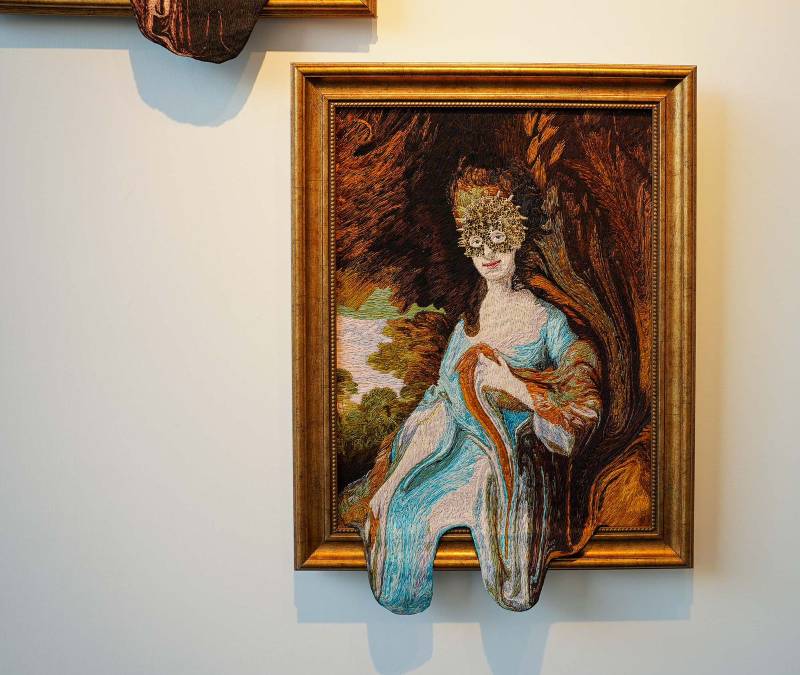
LAHORE: The show kick started at Artsoch in Lahore on March 9 where 40 artworks are displayed which includes contemporary artworks done in techniques of semi-precious stone inlay and chitarkar, portraits and still life done in embroidery works, text based works in digital prints and resin and visual from Islamic geometry and abstraction.
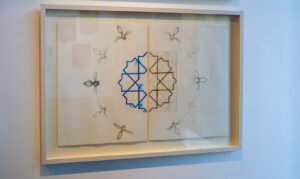
Speaking to The Friday Times (TFT), Amira Haroon, the curator of the show said that Pakistan is a country of numerous ancient civilizations and histories sedimented in both land and water in and around our very permeable borders. To the keen eye of a sensitive artist, they reveal entangled narratives and ecologies across time and space.
For her, her multiple tributaries of our past extend and deepen concepts of relationality, and have initiated an expansive form of kinship—amongst cultures and myths, mysticism, craft, music, literatures and languages - forming the backbone of art today in Pakistan is both this kinship and an archive of the many centuries of history embedded in this land.
Artworks inspired from eastern and western philosophies, poetry and literature
Speaking about her art pieces and the main concept behind them, artist Simeen Farhat said that language is a gift. She was once given this gift of words: "Language begins with a breath. Even though we can no longer hear it, every word ever spoken is contained within the library of the air."
Farhat believes that we communicate through words, the same way we are also expressive through our body language.
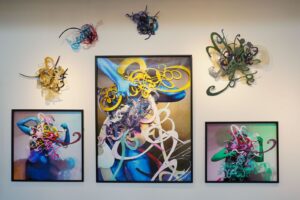
For more than a decade, she has been making text-based sculptures and installations, representing the freedom of a thought process, inspired by both eastern and western philosophy, poetry, and literature. Language, juxtaposed with the human body are also some recurring elements in my work.
For Farhat, words can be poetic like our bodies; in motion or poised.
In her recent body of work, she is infusing human imagery and language as one conjectural form. Farhat is interested in how she can depict the two in these installations, sculptures, photographs, painting, and drawings.
“I have always admired the grace and beauty of the powerful images of goddesses, the nymphs, and the sirens.”
As a contemporary and pluralistic woman of the world with her Pakistani roots, she now creates the avatars of the alluring modern sirens and goddesses.
Art that speaks language understood by all
“My intention is to create art that speaks in a language understood by many, regardless of their age, race, genders, and global identities,” she concluded.
Artist Meherunnisa Asad said that the series is a reinvention of traditional craft techniques in the modern context, and the works are both deeply rooted in the past while maintaining a contemporary aesthetic.
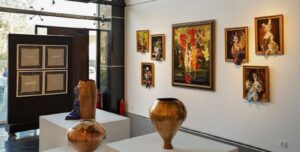
Work inspired from Gandhara civilisation
Taking inspiration from vessels from the Gandhara civilisation, Andy Warhol's depiction of the "ordinary '', and the flawless transition of materiality in nature, this body of work is about retracing the past in order to create something novel and yet timeless.
In addition to natural stone, the series is tied together by the use of copper, a symbol of spirituality, in the age of the Buddhist Candhara civilization of which modern day Peshawar was once the capital city.
“For this, I collaborated with a fifth-generation copper workshop in Peshawar to hand craft vessels that carry both time and experience symbolized by Peshawar,” she said.
Through her practice, she is re-constructing identity, both for herself and for the communities with whom she collaborates.
“I see my art as a way of piecing together fragments of memory and experienced history,” Asad said.
Recalling living through the 2000's in a frontier town which was a hub to the conflict border economy, her memory is flooded with smuggled American food brands, such as Campbell's soup cans, that infiltrated the bazaars of Peshawar which were originally meant to cater to the US troops in Afghanistan.
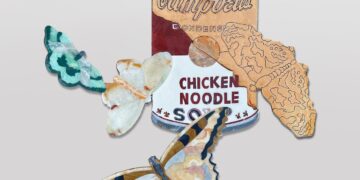
“I link these commodities with Andy Warhol's repetition of Campbell's soup cans and their infiltration into the fine art world which later become one of the most recognizable icons of the pop art movement,” the artist said.
Regarding sameness and a robotic replication of images, Warhol attempts to become a machine devoid of emotion.
“In a paradox, I take that thought and recreate it into a piece with its own identity, morphing machine-made quality into a meticulously hand-crafted pietra dura piece that displays raw human emotion,” she said.
Artworks inspired from sufi school of thought
Artist Huma Shoaib work predominantly takes a great influence from the sufi school of thought mainly for its openness and tolerant nature. Interchangeably, sufi teachings are generally identified as highly individualistic and harmonious practice while being on the contrary.
“While observing the sporadic existence of dervish from the rise of sufism centuries ago, having taken a vow of selfless love and distancing from the norms of society, they were and until now deemed as controversial figures,” Shoaib said.
For her, their presence brings uneasiness in social settings and questions the elaborate ways of the tediously complicated belief system.
Similar to the silent uneasiness I try to achieve through my practice. Manifesting creatures like bees, birds and fish as symbols for their inter-religious references, geo-location and life cycle.
Trying to simplify ornate and complex geometric drawings and treat them with fluorescent colors that are industrially made and artificial in nature.
“Implying the need of beliefs becoming more synthetic and fabricated rather than being the innate desire to be spiritual and organic,” she said.

Consistently moving between these ideas the imagery stands as a metaphor and holds a multitude of meaning. Inculcating books in a subtle form notions towards designed learning and the need to withdraw what has been taught. Coming forth as a process of unlearning a plethora of information being fed over a period of time.
“In totality my practice melts down to a consistent effort in breaking down or simplifying the complexity of fabricated information into the importance of one single entity. One minimal existence that contains all,” she concluded.
ArtSoch is a vibrant gallery that displays a diverse mix of unique art forms by established and emerging artists. Our well-known art critique selects representations based on a variety of subjects and mediums giving each artist a chance to shine.
Artist Mariam Hanif, who is the owner of ArtSoch told TFT that they display collections including exclusive sculptures, drawings, exquisite paintings, watercolor, digital and mixed media that brings a soul to a black canvas.
Artist Mariam Agha in her works used indigenous traditional techniques of tapestries and needle embroidery to depict western ideas of beauty. Her works are done in multiple layers of silk threads with a rich renaissance color palette.
Her work style lies in between aesthetics of wast and west.
"She deconstructs our regional thread work and tapestry techniques in a perpetual quest to understand the real and representational concepts surrounding love. The images she creates are hauntingly beautiful and multilayered with meaning," said Ms Haroon.
For her, handkerchief works were the highlight of the show as the choice of color,concept and technique is reminiscent of our collective history of textiles found in our region. The handkerchief aka Romal was an essential day to day object of our culture.
Four works from the Urdu text "Ishq","Sabr","Naseeb" and "Kabool Ha" are written on the set of four white handkerchiefs with white cotton thread.
The works are a brilliant amalgamation of history, memory, and belonging to literature.
The show will conclude on March 20.

Speaking to The Friday Times (TFT), Amira Haroon, the curator of the show said that Pakistan is a country of numerous ancient civilizations and histories sedimented in both land and water in and around our very permeable borders. To the keen eye of a sensitive artist, they reveal entangled narratives and ecologies across time and space.
For her, her multiple tributaries of our past extend and deepen concepts of relationality, and have initiated an expansive form of kinship—amongst cultures and myths, mysticism, craft, music, literatures and languages - forming the backbone of art today in Pakistan is both this kinship and an archive of the many centuries of history embedded in this land.
Artworks inspired from eastern and western philosophies, poetry and literature
Speaking about her art pieces and the main concept behind them, artist Simeen Farhat said that language is a gift. She was once given this gift of words: "Language begins with a breath. Even though we can no longer hear it, every word ever spoken is contained within the library of the air."
Farhat believes that we communicate through words, the same way we are also expressive through our body language.

For more than a decade, she has been making text-based sculptures and installations, representing the freedom of a thought process, inspired by both eastern and western philosophy, poetry, and literature. Language, juxtaposed with the human body are also some recurring elements in my work.
For Farhat, words can be poetic like our bodies; in motion or poised.
In her recent body of work, she is infusing human imagery and language as one conjectural form. Farhat is interested in how she can depict the two in these installations, sculptures, photographs, painting, and drawings.
“I have always admired the grace and beauty of the powerful images of goddesses, the nymphs, and the sirens.”
As a contemporary and pluralistic woman of the world with her Pakistani roots, she now creates the avatars of the alluring modern sirens and goddesses.
Art that speaks language understood by all
“My intention is to create art that speaks in a language understood by many, regardless of their age, race, genders, and global identities,” she concluded.
Artist Meherunnisa Asad said that the series is a reinvention of traditional craft techniques in the modern context, and the works are both deeply rooted in the past while maintaining a contemporary aesthetic.

Work inspired from Gandhara civilisation
Taking inspiration from vessels from the Gandhara civilisation, Andy Warhol's depiction of the "ordinary '', and the flawless transition of materiality in nature, this body of work is about retracing the past in order to create something novel and yet timeless.
In addition to natural stone, the series is tied together by the use of copper, a symbol of spirituality, in the age of the Buddhist Candhara civilization of which modern day Peshawar was once the capital city.
“For this, I collaborated with a fifth-generation copper workshop in Peshawar to hand craft vessels that carry both time and experience symbolized by Peshawar,” she said.
Through her practice, she is re-constructing identity, both for herself and for the communities with whom she collaborates.
“I see my art as a way of piecing together fragments of memory and experienced history,” Asad said.
Recalling living through the 2000's in a frontier town which was a hub to the conflict border economy, her memory is flooded with smuggled American food brands, such as Campbell's soup cans, that infiltrated the bazaars of Peshawar which were originally meant to cater to the US troops in Afghanistan.

“I link these commodities with Andy Warhol's repetition of Campbell's soup cans and their infiltration into the fine art world which later become one of the most recognizable icons of the pop art movement,” the artist said.
Regarding sameness and a robotic replication of images, Warhol attempts to become a machine devoid of emotion.
“In a paradox, I take that thought and recreate it into a piece with its own identity, morphing machine-made quality into a meticulously hand-crafted pietra dura piece that displays raw human emotion,” she said.
Artworks inspired from sufi school of thought
Artist Huma Shoaib work predominantly takes a great influence from the sufi school of thought mainly for its openness and tolerant nature. Interchangeably, sufi teachings are generally identified as highly individualistic and harmonious practice while being on the contrary.
“While observing the sporadic existence of dervish from the rise of sufism centuries ago, having taken a vow of selfless love and distancing from the norms of society, they were and until now deemed as controversial figures,” Shoaib said.
For her, their presence brings uneasiness in social settings and questions the elaborate ways of the tediously complicated belief system.
Similar to the silent uneasiness I try to achieve through my practice. Manifesting creatures like bees, birds and fish as symbols for their inter-religious references, geo-location and life cycle.
Trying to simplify ornate and complex geometric drawings and treat them with fluorescent colors that are industrially made and artificial in nature.
“Implying the need of beliefs becoming more synthetic and fabricated rather than being the innate desire to be spiritual and organic,” she said.

Consistently moving between these ideas the imagery stands as a metaphor and holds a multitude of meaning. Inculcating books in a subtle form notions towards designed learning and the need to withdraw what has been taught. Coming forth as a process of unlearning a plethora of information being fed over a period of time.
“In totality my practice melts down to a consistent effort in breaking down or simplifying the complexity of fabricated information into the importance of one single entity. One minimal existence that contains all,” she concluded.
ArtSoch is a vibrant gallery that displays a diverse mix of unique art forms by established and emerging artists. Our well-known art critique selects representations based on a variety of subjects and mediums giving each artist a chance to shine.
Artist Mariam Hanif, who is the owner of ArtSoch told TFT that they display collections including exclusive sculptures, drawings, exquisite paintings, watercolor, digital and mixed media that brings a soul to a black canvas.
Artist Mariam Agha in her works used indigenous traditional techniques of tapestries and needle embroidery to depict western ideas of beauty. Her works are done in multiple layers of silk threads with a rich renaissance color palette.
Her work style lies in between aesthetics of wast and west.
"She deconstructs our regional thread work and tapestry techniques in a perpetual quest to understand the real and representational concepts surrounding love. The images she creates are hauntingly beautiful and multilayered with meaning," said Ms Haroon.
For her, handkerchief works were the highlight of the show as the choice of color,concept and technique is reminiscent of our collective history of textiles found in our region. The handkerchief aka Romal was an essential day to day object of our culture.
Four works from the Urdu text "Ishq","Sabr","Naseeb" and "Kabool Ha" are written on the set of four white handkerchiefs with white cotton thread.
The works are a brilliant amalgamation of history, memory, and belonging to literature.
The show will conclude on March 20.

